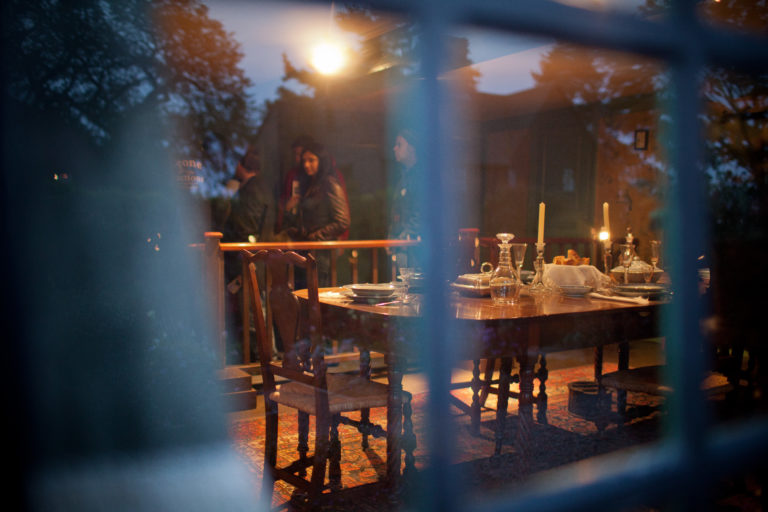
A tour passes through the House of the Seven Gables in Salem, Massachusetts. Image by MA Office of Travel & Tourism/MA Office of Travel & Tourism / Flickr, Some Rights Reserved.
Wary of Abundance: An Afternoon in an Old House
When I find myself in New England I make time, if I possibly can, to visit an old house. Many of these sturdy relics where revolutionaries met in living rooms and “little women” knitted and brooded are now museums, staffed by women in colonial costume from the local historical society. The best of these tours are led by guides who pause affectionately over a piece of furniture or an odd bit of cookware or a homely implement whose use is a mystery to the modern observer to tell stories.
“This is a lantern and milk warmer for the nursery,” one says, holding up a small contraption made of tin. “At bedtime the mother would fill the little pitcher on top with milk for the children, light the candle in the holder underneath, and carry it upstairs where it lit her way to the bedrooms.”
The clichés about Yankee ingenuity, shrewdness, and economy are made visible in these houses. I am struck by the old New Englanders’ determination to preserve civilities and creature comforts in a climate so inhospitable much of the year. Every house has a warming pan. The guide takes it up by its long handle and opens the lid to show us where they put in coals from the fireplace and then slid it back and forth between the sheets before jumping in.
In a tavern in Lexington I inspect a little metal coal box to be carried to church and set under one’s skirts to warm one’s feet during the long cold services. “The mistress of the house,” the guide explained, “was most often the one to use the coal-carrier. The master would take the family dog along for the same purpose. And the children were given hot potatoes to put into their pockets.”
The blue wrappers on bullet-shaped cones of sugar from England were used to make dye. “The women who could wear dresses this color,” the guide explains, holding one aloft, “had status; only the most affluent townspeople could afford sugar.”

The kitchen table is reversible — one side for flouring, slicing, kneading, and general kitchen labor, the other for eating. Beds and tables tuck into and under each other; the old Puritan virtue of frugality extends to sagacious use of limited space. A chair in the Emerson house has a drawer under it for Ralph Waldo’s gloves, added by his friend Thoreau to accommodate his habit of misplacing them.
Other chairs are designed with similar considerations in mind: the corner chair where a lady could spread her skirts or a man (in earlier times) situate his sword with comfort; the wing-back for warmth and protection in drafty, uninsulated rooms; the high-backed bench that confined the fire’s heat to one section of the same chilly parlor, and under whose seat more wood could be stored.
In the Witch House in Salem the guide points to a long, exceedingly narrow dining table and explains:
“The colonists were not allowed to keep lumber wider than 18 inches; those valuable pieces were reserved for the crown. You’ll notice that all the floorboards here are made of wood less than 18 inches wide, and the narrow table is a result of the same prohibition.”
The House of the Seven Gables, a mile away, has a number of hidden cupboards and a secret passageway and attic room, disguised by false doors and sections of paneling that open if you know where to find the sequestered latch. Space is valuable. Space is a commodity, not to be wasted, as are heat and light and the wax and wood that provide them.
Dresses were “turned,” reshaped and cut down for little girls, and made over into aprons and pillow covers and finally they scatter the remains of their home-dyed colors in patchwork quilts and rag rugs. Nothing was replaced if it could be repaired. These are the products of scarcity. I miss something of the ingenuity that has been largely lost in the great gains of mechanization and mass production.

This is not idle nostalgia; I wouldn’t really want to depend upon such devices for my daily comforts. But necessity itself, that old mother of invention, the force that drives us to resourceful, creative, thoughtful use of time, space, energy, and whatever is at hand is something many of us haven’t known intimately or for long. Whatever virtues come with “making do” must be won in different ways now, if they are to be won at all: frugality, ingenuity, thoroughness, attentiveness to detail, an eye for possibility, and real generosity which can only begin when what is given has cost, time, and skill to make, and has perhaps been paid for by an extra economy, a doing without.
If I begin to sound a bit like an old Yankee preacher it is because I am, like them, wary of abundance and ease even while I enjoy their fruits. I don’t deplore technological progress, but I deplore laziness and passivity, and I wonder how much both those diseases have to do with an indirect and incompetent relation to the things we use, most of which most of us are unable either to make or to repair.
I asked my daughter one night, who was, at 16, baking bread for the first time, “What are some things you think every person ought to know how to do?” We came up with a long list:
- Bake bread.
- Change a diaper — and an oil filter and a tire.
- Hem a skirt and sew on a button.
- Create a good soup with no recipe.
- Install shelving.
- Hook up and run a VCR.
- Lay and light a fire.
- Change a fuse.
- Boil a perfect three-minute egg.
- Compose a letter of condolence.
- Plan a party.
- Identify both poisonous and edible plants.
- Swim.
- Deliver a speech.
- Recite a poem.
- Sing in harmony.
- Braid, curl, or cut hair.
- Prune a tree.
- Tend a vegetable garden.
- Use a computer.
- Fill out tax forms.
- Rub a back.
Make things useful. Make them beautiful. Turn them to purposes you’ve considered and claimed. Enjoy what is given and share it. Stretch every muscle and faculty of mind. It’s a good list. It’s worth revisiting from time to time, like old houses, to be reminded of what it might take to stay awake, alive, humble, and humane.

